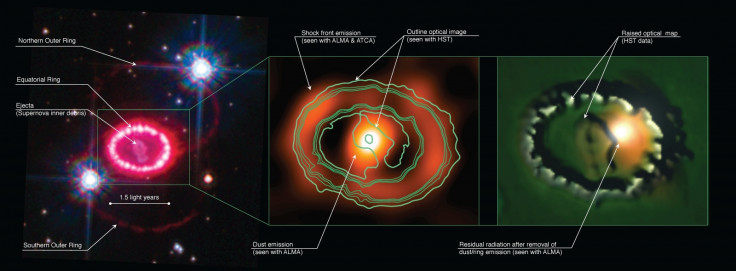Supernova 1987A: Astronomers Carry Out Post-Mortem on Dead Star

Astronomers have carried out a galactic post-mortem on a dead star that exploded suddenly at the edge of a nearby dwarf galaxy.
Supernova 1987A, or SN1987A, was first observed in 1987 when it was seen exploding at the edge of the Large Magellanic Cloud.
Over 25 years later, researchers at the University of Western Australia have now used more advanced radio telescopes based in Australia and Chile to peer inside the remains of the dead star.
Study leader Giovanna Zanardo, who used the Alma telescope in Chile to observe the supernova, said: "By combining observations from the two telescopes we've been able to distinguish radiation being emitted by the supernova's expanding shock wave from the radiation caused by dust forming in the inner regions of the remnant.

"This is important because it means we're able to separate out the different types of emission we're seeing and look for signs of a new object which may have formed when the star's core collapsed. It's like doing a forensic investigation into the death of a star."
Since its discovery, SN19871has provided astronomers with huge amounts of information about supernovas. Published in the Astrophysical Journal, Zanardo said the latest observations have led to the discovery of something entirely new.
"Our observations with the Atca and Alma radio telescopes have shown signs of something never seen before, located at the center or the remnant. It could be a pulsar wind nebula, driven by the spinning neutron star, or pulsar, which astronomers have been searching for since 1987.
"It's amazing that only now, with large telescopes like Alma and the upgraded Atca, we can peek through the bulk of debris ejected when the star exploded and see what's hiding underneath."
© Copyright IBTimes 2025. All rights reserved.






















